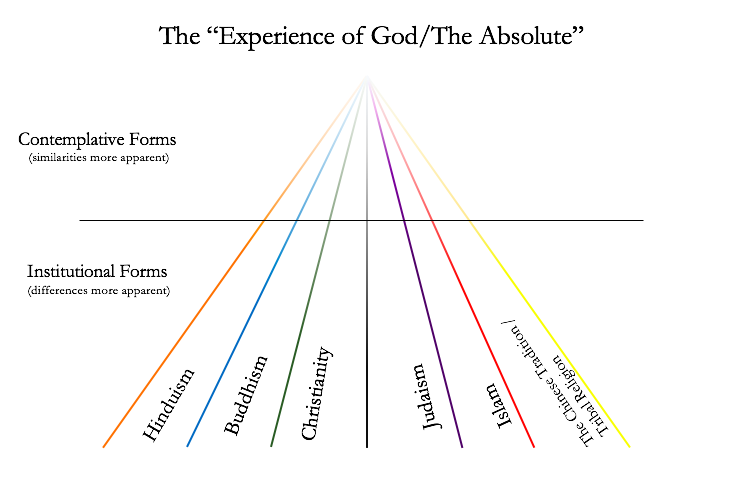

This is a dump of cool things I learn about spirituality across many traditions.
You can read in order or perhaps choose from this list:

Perennial philosophy: there is truth that can be accessed throughout different ages and culture, so it’s not contextual to one specific place.

“Do not be curious to know more, I beg you. Only become increasingly faithful to this work until it becomes your whole life.
To put it more simply, let that mysterious grace move in your spirit as it will and follow wherever it leads you. Let it be the active doer and you the passive receiver.”
“Strike that thick cloud of unknowing with the sharp dart of
longing love, and on no account whatever think of giving up.”
- an anonymous 14th Century text called The Cloud of Unknowing
“If your practice does not bring you joy, you are not practicing correctly…When I wanted to become a novice monk, my family thought that a monk's life would be too difficult for me. But I knew it was the only way I could be happy, and I persisted. Once I became a novice, I felt as happy and free as a bird in the sky. When it came time for chanting sutras, I felt as though I had been invited to a concert. Sometimes on moonlit nights, when the monks were chanting the sutras standing by the crescent pond, I thought I was in paradise listening to angels. When I could not attend morning chanting because I had another task, just hearing the words of the Shurangama Sutra coming from the Buddha Hall brought me happiness. Everyone at Tu Hieu Pagoda practiced with interest, joy, and diligence. There was no forced effort, just the love and support of our teacher and brothers in the practice.”
from “The Heart of the Buddha’s Teaching: Transforming Suffering into Peace, Joy, and Liberation” by Thich Nhat Hanh
This took me so long to learn because I didn’t know there were so many ways to practice and I didn’t like the meditation I was attempting to force myself into!
A GIANT guide to ancient Indian philosophy:
http://lukemuehlhauser.com/ancient-indian-philosophy-a-painless-introduction/
“The Indian conceptions of space and time were vast. The past stretched back into infinity, or at least for billions of years. The Earth was but one of millions of worlds in an infinite universe. Accordingly, Indian thought emphasized the smallness of Earth, the insignificance of worldly possessions, and the transient nature of human life.
Perhaps most centrally, the ancient Indians did not see philosophy as a disinterested investigation of the nature of reality. Rather, philosophy was a practical matter: useful for daily life and in shaping one's destiny.”
An article about the bardos in Tibetan Buddhism and what happens at death:
https://www.andrewholecek.com/after-death-states-the-bardos-in-tibetan-buddhism/
“In Plato's Phaedrus, he differentiates ordinary mania (madness) from theomania (divine madness). He delineates four types of theomania - Poetic, Telestic, Mantic, and Erotic. These gifts from the gods liberate the experiencer, as opposed to ordinary mania / madness which is psychologically destabilizing. Poetic theomania is inspired by the Muses - Plato goes so far as to explicitly say that sane people cannot write good poetry. They must be possessed, god-mad, and only then can they serve as a channel for true poetry. “
– from Connor Marvin’s essay Stop Making Sense: Dionysian Mysteries, Counterculture, and the Liberatory Power of Ecstasy
“Egregore is an occult concept representing a certain non–physical entity that arises from the collective thoughts of a distinct group of people.” – Wikipedia
Avalokiteshvara (Guanyin)
A paper on a queer interpretation of Guanyin:
https://digitalcommons.ursinus.edu/cgi/viewcontent.cgi?article=1006&context=rel_hon
“When people start to meditate or to work with any kind of spiritual discipline, they often think that somehow they’re going to improve, which is a sort of subtle aggression against who they really are.
But lovingkindness - maitri - toward ourselves doesn't mean getting rid of anything. Maitri means that we can still be crazy after all these years. We can still be angry after all these years. We can still be timid or jealous or full of feelings of unworthiness. The point is not to try to change ourselves.”
A Conversation with Terence McKenna and Ram Das (1992):
“If we don't have any thoughts, how will wisdom develop? Some people simply want to sit with a blank mind. That's wrong understanding.”
“Science vs Religion? Wrong Question!” by Foolish Fish on YouTube was really fascinating to watch (I highly recommend his channel overall):
He explains:
1. Realism is Aristotle’s model of the world where the basic building block is the atom. In this view, consciousness comes from atoms.
2. Idealism is the model by Plato where the basic building block is consciousness. In this view, atoms exist from consciousness.
3. Most religious people are actually realists in the same way scientists are. The only difference between them and scientists is that they believe a god created the atoms.
4. The minority of the religious people are idealists, who get shunned by the religious realists. These are the mystics: the sufis, daoists, etc.
3 websites with full courses on spirituality:
https://buddhistuniversity.net/courses/ (Buddhism)
https://www.quareia.com/apprentice-module-1 (occultism)
https://studybuddhism.com (Buddhism)
“As esoteric students, we regard pleasure only as a means whereby we can become nobler for the sake of the world.”
– from “How to Know Higher Worlds” by Rudolf Steiner
“What you are devoted to, it doesn’t matter. You must walk with absolute devotion. Devotion means you are devoid of yourself. Devotion means a heightened state of receptivity because you are no more full of yourself.”
– Sadhguru
This detailed, info-packed article gives evidence that the Bible wasn’t always interpreted literally. It was viewed as both describing historical events and allegory until the 19th century when modernity happened and then most people became literalists.
The origin of the phrase “memento mori” (remember death) is in ancient Rome but it turned into a big Catholic thing!
“Sts. Jerome, Francis, Gerard, and Mary Magdalene are among the saints commonly depicted with skulls in religious art. St. Elizabeth of Hungary used a simple coffin to contain all the religious goods she gathered and gave to the poor so she could remember that earthly things were meaningless. Pope Alexander VIII had the great artist Bernini carve a small marble coffin he kept upon his desk as a reminder that at the end of his life he would be held accountable to God. All of these are tangible expressions of memento mori.”
– from https://www.goodcatholic.com/memento-mori-remember-your-death/
Also, dang this is poetic:
” The grass withers, the flower fades when the breath of the LORD blows on it; surely the people are grass” (Is. 40:7)
The Sabian symbols were produced in 1925 by clairvoyant Elsie Wheeler. They are 360 phrases corresponding to each degree on the wheel of the zodiac, meaning your birthday determines which one you have.
If you look at your birth chart and find the degree of the sun, you can then look here for your Sabian symbol: https://www.jamesburgess.com/list-of-sabians
For example, I have the sun at 3-4 degrees Scorpio, which is the phrase “A Youth Carries A Lighted Candle In A Devotional Ritual”.
A Ram Dass lecture. Clicked for the catchy title, stayed for the account of what the 60s were like:
“Religion presents a finite simulacrum and calls it God; at this point, according to Kook, certain people realize the finite cannot be God, so they reject religions claim and are left with no God. These atheists have grasped an essential part of the truth….”
– from the introduction to The Pangs of Cleansing
“Religion is influenced to become more fundamentalist by the very force of secularism that seeks to control it; this eventual increase in reactivity, absolutism and polarisation feeds back into the tightening of secularist policies, which become increasingly more strict even as the consequences of this restriction increase the hostilities of religious groups towards the state.”
– from “Fundamentalism, Secularism and Modernity” by enterthevessel
In the east, the feminine is more “active” and the masculine is the receptive one. Shiva, the masculine, is a dispassionate witness. While Shakti, the feminine, is the generator, operator, destroyer, concealer, revealer who is constantly changing. Shiva is the witnesser and Shakti is that which is witnessed.